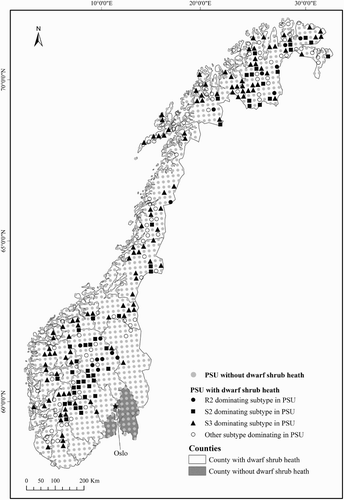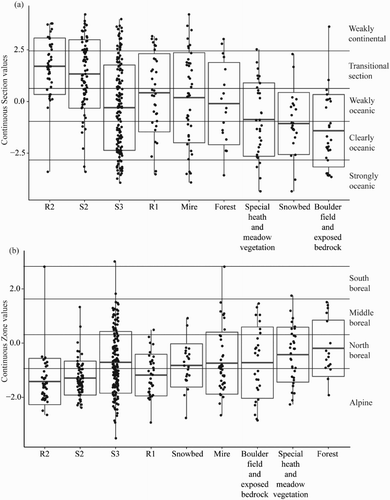Figures & data
Table 1. Description, number and percentage of Secondary Statistical Unit (SSU) points in dwarf shrub heath polygons; the subtypes are based on, or generalized from the detailed description system for vegetation in Norway (Fremstad Citation1997); subtypes defined as dwarf shrub heath in Rekdal & Larsson’s guide for vegetation mapping using the VK50 system (Rekdal & Larsson Citation2005) are shaded grey
Fig. 1. Distribution of the AR18X18 grid throughout Norway; the dominating vegetation type is decided by the highest number of Secondary Statistical Unit (SSU) points in each Primary Statistical Unit (PSU); R2: Betula nana – Empetrum nigrum coll. subtype. S2: Juniperus communis – Betula nana heath; S3: Vaccinium myrtillus – Phyllodoce caerulea heath and Empetrum nigrum coll. heath

Table 2. The F-values and the P-values from the one-way ANOVA test (8 and 441 df) for Sections and Zones, and the coefficient values from the first linear discriminant
Fig. 2. Box plot with mean and ± SD of the distribution of the different subtypes in dwarf shrub heath according to the environmental gradients; a) Sections; b) Zones (representing principal components PC1 and PC2 in Bakkestuen et al. Citation2008); R1: Loiseleuria procumbens – lichen/bryophyte subtype; R2: Betula nana – Empetrum nigrum coll. subtype. S2: Juniperus communis – Betula nana heath; S3: Vaccinium myrtillus – Phyllodoce caerulea heath and Empetrum nigrum coll. heath

